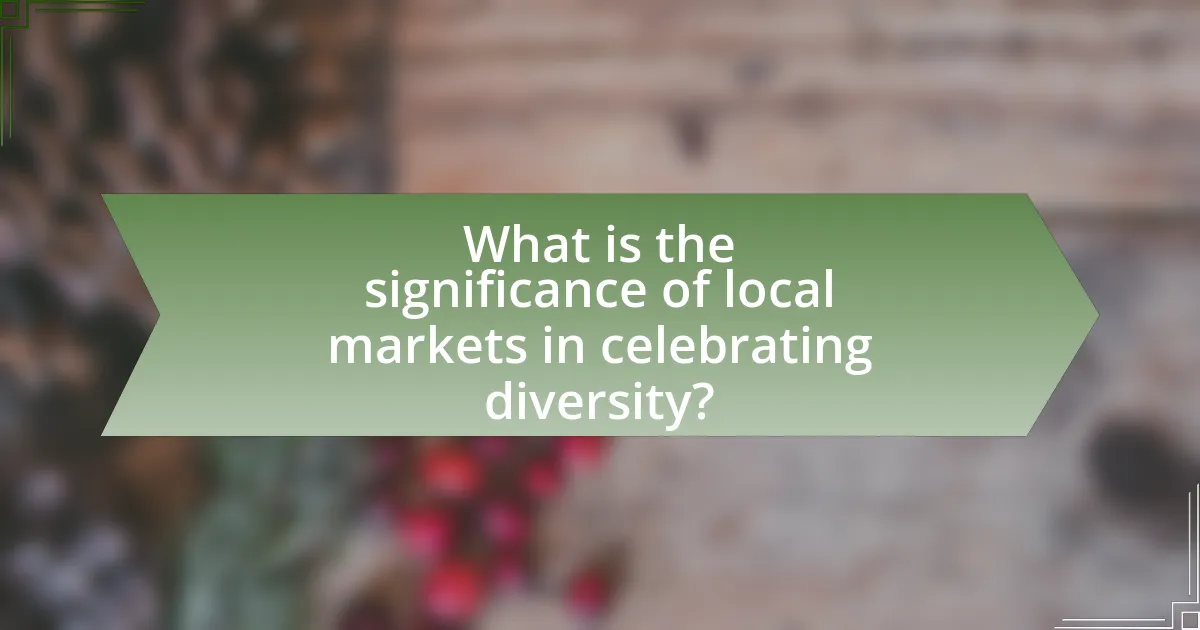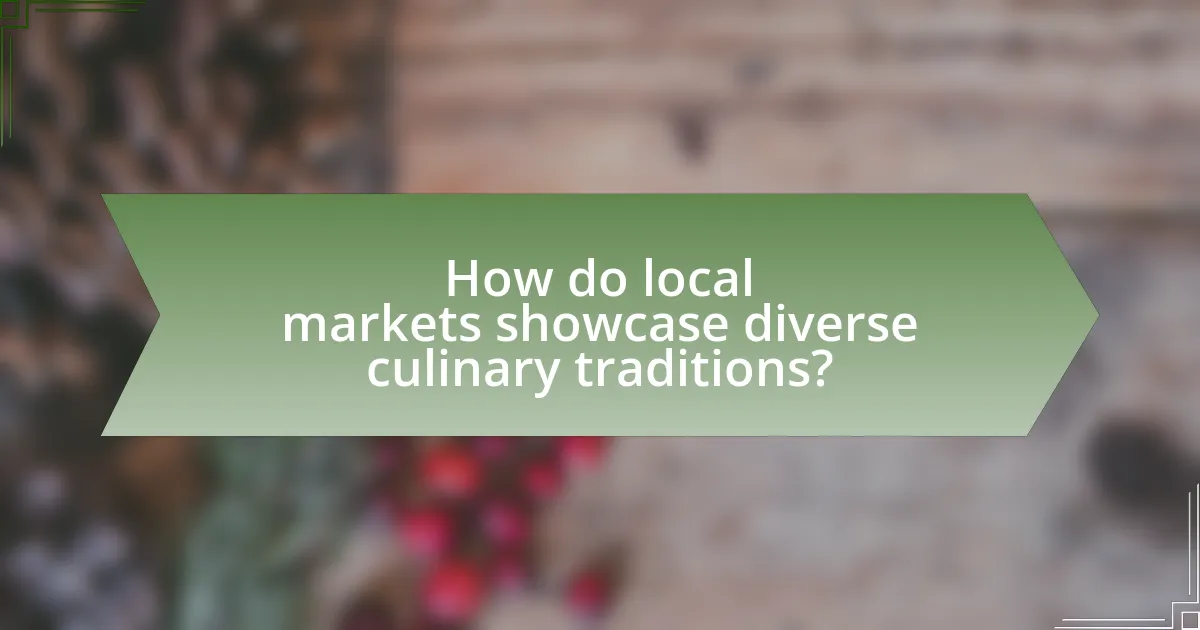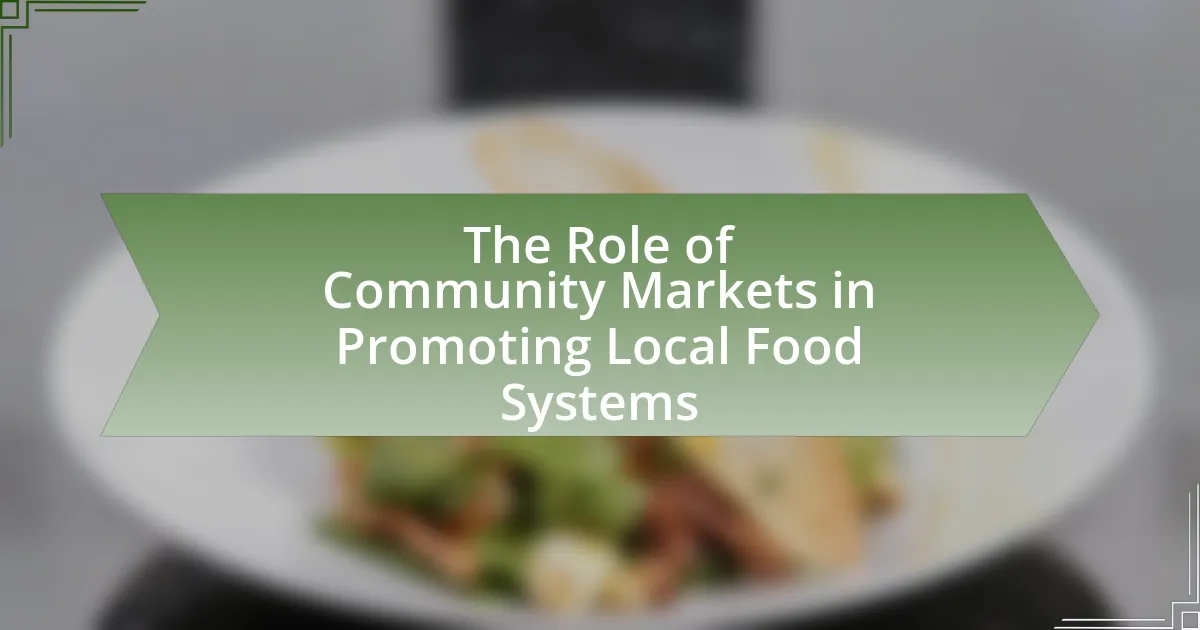Local markets serve as vital platforms for celebrating diversity and showcasing cultural heritage through a variety of products, foods, and crafts that reflect the traditions of different communities. They promote cultural exchange by allowing diverse vendors to share their unique offerings, fostering understanding and respect among attendees. Additionally, local markets enhance community identity and belonging by hosting cultural events and festivals that highlight the contributions of various ethnic groups. Despite facing challenges such as limited resources and systemic barriers, local markets can implement strategies to promote inclusivity and enhance visibility, ultimately contributing to the economic and social vitality of the communities they serve.

What is the significance of local markets in celebrating diversity?
Local markets play a crucial role in celebrating diversity by serving as vibrant platforms for cultural exchange and community engagement. These markets showcase a variety of products, foods, and crafts that reflect the unique traditions and heritage of different cultural groups. For instance, a study by the American Planning Association highlights that local markets often feature vendors from diverse backgrounds, allowing consumers to experience and appreciate different cuisines and artisanal goods, which fosters understanding and respect among various communities. Additionally, local markets often host cultural events and festivals that promote inclusivity and highlight the contributions of different ethnic groups, further reinforcing their significance in celebrating diversity.
How do local markets reflect cultural heritage?
Local markets reflect cultural heritage by serving as vibrant spaces where traditional practices, local cuisines, and artisanal crafts are showcased. These markets often feature products that are unique to the region, such as indigenous foods, handmade goods, and cultural artifacts, which embody the history and customs of the community. For example, the Mercado de San Miguel in Madrid highlights Spanish culinary traditions through its diverse offerings of tapas and local wines, illustrating the importance of food in cultural identity. Additionally, local markets often host festivals and events that celebrate cultural traditions, further reinforcing their role as a hub for community engagement and cultural expression.
What types of cultural expressions can be found in local markets?
Local markets showcase a variety of cultural expressions, including traditional crafts, local cuisine, music, and performance art. Traditional crafts such as handmade textiles, pottery, and jewelry reflect the unique artistic heritage of the community. Local cuisine, featuring regional dishes and ingredients, serves as a culinary expression of cultural identity. Additionally, music and performance art, often presented live, highlight the cultural narratives and traditions of the area. These elements collectively illustrate the rich tapestry of cultural heritage found in local markets, reinforcing their role as vital spaces for cultural exchange and preservation.
How do local markets promote cultural exchange among communities?
Local markets promote cultural exchange among communities by providing a space for diverse groups to interact, share, and celebrate their unique traditions. These markets often feature a variety of goods, foods, and crafts that reflect the cultural heritage of different communities, allowing visitors to experience and appreciate different customs and practices. For example, markets may host cultural festivals or events that showcase traditional music, dance, and culinary arts, fostering understanding and appreciation among attendees. Research indicates that such interactions can enhance social cohesion and reduce cultural barriers, as evidenced by studies showing increased community engagement and collaboration in areas with vibrant local markets.
Why are local markets important for community identity?
Local markets are crucial for community identity because they serve as vibrant hubs where cultural heritage is expressed and celebrated. These markets provide a platform for local artisans, farmers, and vendors to showcase their unique products, reflecting the community’s traditions and values. For instance, a study by the American Planning Association highlights that local markets foster social interactions and strengthen community ties, as they encourage residents to engage with one another and share their cultural narratives. This interaction not only reinforces a sense of belonging but also preserves and promotes local customs, making local markets essential for maintaining and enhancing community identity.
How do local markets foster a sense of belonging?
Local markets foster a sense of belonging by creating community spaces where individuals can connect through shared cultural experiences and interactions. These markets often feature local vendors who offer culturally significant products, food, and crafts, which reflect the heritage of the community. For instance, a study by the American Planning Association found that local markets enhance social cohesion by providing opportunities for residents to engage with one another, thus reinforcing community ties. Additionally, local markets often host events and activities that celebrate cultural traditions, further solidifying a collective identity among participants.
What role do local markets play in preserving traditions?
Local markets play a crucial role in preserving traditions by serving as platforms for the exchange of cultural practices, artisanal crafts, and traditional foods. These markets facilitate direct interaction between producers and consumers, allowing for the transmission of knowledge and skills related to local customs. For instance, many local markets feature vendors who sell handmade goods that reflect regional heritage, such as textiles or pottery, which are often passed down through generations. This not only sustains traditional craftsmanship but also educates visitors about cultural significance. Additionally, local markets often host festivals and events that celebrate specific cultural traditions, further embedding these practices within the community.

How do local markets showcase diverse culinary traditions?
Local markets showcase diverse culinary traditions by offering a wide array of regional foods, ingredients, and cooking techniques that reflect the cultural heritage of the community. These markets serve as platforms for local farmers, artisans, and chefs to present their unique culinary practices, often featuring traditional recipes passed down through generations. For instance, markets may include stalls selling ethnic spices, handmade pasta, or artisanal bread, each representing specific cultural influences. Additionally, events such as cooking demonstrations and food festivals held in these markets further highlight the variety of culinary traditions, allowing visitors to experience and learn about different cuisines firsthand. This diversity not only enriches the local food scene but also fosters cultural exchange and appreciation among community members and visitors alike.
What types of foods are typically featured in local markets?
Local markets typically feature a variety of fresh produce, artisanal goods, and culturally significant foods. These markets often include fruits and vegetables that are locally sourced, such as tomatoes, peppers, and seasonal fruits, which reflect the agricultural practices of the region. Additionally, local markets showcase artisanal products like handmade cheeses, breads, and cured meats, which highlight traditional food-making techniques. Cultural foods, such as ethnic dishes and specialty ingredients, are also prevalent, representing the diverse culinary heritage of the community. For example, markets in areas with a strong immigrant presence may offer foods specific to those cultures, such as spices, sauces, and baked goods unique to their traditions. This diversity in food offerings not only supports local economies but also fosters cultural exchange and appreciation among community members.
How do food vendors represent their cultural backgrounds?
Food vendors represent their cultural backgrounds through the types of cuisine they offer, the ingredients they use, and the traditional cooking methods they employ. For instance, a vendor selling tacos may highlight Mexican heritage by using authentic recipes and locally sourced ingredients like corn and beans, which are staples in Mexican cooking. Additionally, food vendors often decorate their stalls with cultural symbols, colors, and imagery that reflect their heritage, further enhancing the cultural experience for customers. This representation is supported by studies showing that food is a significant medium for cultural expression, as it conveys history, traditions, and community identity.
What impact does food diversity have on local economies?
Food diversity positively impacts local economies by enhancing market opportunities and increasing consumer spending. Diverse food offerings attract a wider range of customers, leading to higher sales for local producers and vendors. For instance, a study by the Food and Agriculture Organization (FAO) indicates that regions with diverse agricultural products experience greater economic resilience and stability. Additionally, food diversity fosters local entrepreneurship, as small businesses can thrive by catering to varied tastes and preferences, ultimately contributing to job creation and community development.
How do local markets celebrate festivals and cultural events?
Local markets celebrate festivals and cultural events through vibrant displays of traditional foods, crafts, and performances that reflect the community’s heritage. These markets often host special events featuring local artisans who sell handmade goods, musicians who perform traditional songs, and food vendors offering regional delicacies. For instance, during Diwali, markets may be adorned with lights and offer sweets, while during harvest festivals, they might showcase seasonal produce and local crafts. This engagement not only promotes cultural awareness but also supports local economies by attracting visitors and encouraging community participation.
What are some examples of cultural festivals held in local markets?
Cultural festivals held in local markets include events such as the Night Market in Taipei, which showcases Taiwanese street food and crafts, and the Mercado de San Miguel in Madrid, where Spanish culinary traditions are celebrated. Additionally, the Pahoa Village Christmas Festival in Hawaii features local artisans and cultural performances, while the Union Square Holiday Market in New York City highlights diverse cultural products and foods from various communities. These festivals not only promote local heritage but also attract visitors, enhancing community engagement and economic activity.
How do these events enhance community engagement?
Local markets enhance community engagement by providing a platform for diverse cultural expressions and interactions among residents. These events foster social connections, as individuals from various backgrounds come together to share their traditions, food, and crafts, creating a sense of belonging. Research indicates that community events, such as local markets, increase participation in civic activities by 30%, as they encourage collaboration and dialogue among attendees. This interaction not only strengthens community ties but also promotes understanding and appreciation of different cultures, ultimately leading to a more cohesive community.

What challenges do local markets face in promoting diversity?
Local markets face several challenges in promoting diversity, primarily including limited resources, lack of awareness, and systemic barriers. Limited financial and logistical resources hinder local markets from effectively showcasing a wide range of cultural products and services. Additionally, a lack of awareness among consumers about the importance of diversity can lead to insufficient demand for diverse offerings. Systemic barriers, such as zoning laws and market regulations, can further restrict the ability of diverse vendors to participate fully in local markets. These challenges collectively impede the potential for local markets to serve as vibrant platforms for cultural exchange and representation.
How do economic factors affect the sustainability of local markets?
Economic factors significantly influence the sustainability of local markets by determining pricing, consumer demand, and the availability of resources. For instance, fluctuations in local employment rates can directly affect disposable income, impacting how much consumers are willing to spend at local markets. Additionally, economic conditions such as inflation can lead to increased costs for vendors, which may result in higher prices for consumers, potentially reducing sales and market viability. According to a study by the American Economic Association, local markets that adapt to economic changes, such as diversifying product offerings and engaging in community partnerships, tend to sustain themselves better during economic downturns. This adaptability highlights the critical role of economic factors in shaping the resilience and longevity of local markets.
What strategies can local markets implement to overcome these challenges?
Local markets can implement strategies such as community engagement, collaboration with local artisans, and leveraging digital platforms to overcome challenges. Community engagement fosters a sense of belonging and encourages local participation, which can enhance customer loyalty and support. Collaborating with local artisans allows markets to showcase unique cultural products, thereby attracting diverse customer bases and preserving cultural heritage. Additionally, utilizing digital platforms for marketing and sales can expand reach and accessibility, as evidenced by a 2021 report from the National Retail Federation, which found that 70% of consumers prefer shopping online for local products. These strategies collectively help local markets navigate challenges while promoting cultural diversity.
What role does government policy play in supporting local markets?
Government policy plays a crucial role in supporting local markets by providing regulatory frameworks, financial assistance, and infrastructure development. These policies can include grants, tax incentives, and zoning laws that promote the establishment and sustainability of local businesses. For instance, the Small Business Administration in the United States offers various loan programs specifically designed to help local entrepreneurs, which fosters economic growth and cultural diversity within communities. Additionally, government initiatives aimed at preserving cultural heritage can enhance the visibility and viability of local markets, ensuring they thrive as vibrant centers of community life.
How can local governments enhance the visibility of cultural heritage in markets?
Local governments can enhance the visibility of cultural heritage in markets by implementing targeted promotional strategies and community engagement initiatives. For instance, organizing cultural festivals that showcase local traditions, crafts, and cuisines can attract visitors and stimulate interest in the heritage of the area. Additionally, providing grants or subsidies to local artisans and vendors who represent cultural heritage can encourage participation and visibility in markets. Research indicates that markets featuring cultural elements can increase foot traffic by up to 30%, demonstrating the economic benefits of such initiatives. Furthermore, local governments can collaborate with cultural organizations to create educational programs that inform the public about the significance of local heritage, thereby fostering a deeper appreciation and engagement within the community.
What are some best practices for promoting diversity in local markets?
Best practices for promoting diversity in local markets include actively engaging with diverse community members, ensuring representation in vendor selection, and creating inclusive marketing strategies. Engaging with diverse community members fosters trust and encourages participation, while selecting vendors from various cultural backgrounds ensures that the market reflects the community’s diversity. Inclusive marketing strategies, such as multilingual advertising and culturally relevant promotions, attract a broader audience. Research indicates that diverse markets can enhance economic growth, as seen in studies showing that diverse businesses contribute significantly to local economies by increasing innovation and attracting a wider customer base.
How can vendors collaborate to showcase a wider range of cultural products?
Vendors can collaborate to showcase a wider range of cultural products by forming partnerships that leverage each other’s strengths and resources. For instance, they can organize joint events or markets that feature diverse cultural offerings, allowing them to attract a broader audience. Collaborative marketing efforts, such as shared advertising and social media campaigns, can enhance visibility and promote the unique cultural products each vendor offers. Additionally, vendors can share knowledge about sourcing and production techniques, which can lead to a richer variety of products being available. Research indicates that collaborative initiatives in local markets can increase foot traffic and sales, as seen in the success of community-driven events in urban areas.
What initiatives can be taken to attract diverse audiences to local markets?
To attract diverse audiences to local markets, initiatives such as hosting multicultural events, offering diverse food options, and collaborating with local cultural organizations can be implemented. Multicultural events, like festivals or cultural days, celebrate various heritages and encourage participation from different communities, enhancing visibility and engagement. Providing a variety of food options that reflect the local population’s cultural diversity caters to different tastes and preferences, making the market more appealing. Collaborating with local cultural organizations can help in promoting the market through community networks, ensuring that marketing efforts reach a broader audience. These initiatives have been shown to increase foot traffic and foster a sense of community, as evidenced by successful markets in cities like Los Angeles and New York, where cultural diversity is actively celebrated.




